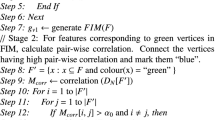Abstract
In this work, a graph-based approach has been adopted for feature selection in case of high-dimensional data. Feature selection intends to identify an optimal feature subset to solve the given learning problem. In an optimal feature subset, only relevant features are selected as “members” and features that have redundancy are considered as “non-members”. This concept of “membership” and “non-membership” of a feature to an optimal feature subset has been represented by a strong intuitionistic fuzzy graph. The algorithm proposed in this work at first maps the feature set of the data as the vertex set of a strong intuitionistic fuzzy graph. Then the association between features represented as an edge-set is decided by the degree of hesitation between the features. Based on the feature association, the Strong Intuitionistic Fuzzy Feature Association Map (SIFFAM) is developed for the datasets. Then a sub-graph of SIFFAM is derived to identify features with maximal non-redundancy and relevance. Finally, the SIFFAM based feature selection algorithm is applied on very high dimensional datasets having features of the order of thousand. Empirically, the proposed approach SIFFAM based feature selection algorithm is found to be competitive with several benchmark feature selection algorithms in the context of high-dimensional data.








Similar content being viewed by others
References
Guyon I and Elisseeff A 2003 An introduction to variable and feature selection. J. Mach. Learn. Res. 3:1157–1182
Swarnkar T and Mitra P 2015 Graph-based unsupervised feature selection and multiview clustering for microarray data. J. Biosci. 40:755–767
Shukla A K, Singh P, and Vardhan M 2018 A hybrid gene selection method for microarray recognition
Yu L and Liu H 2004 Redundancy based feature selection for microarray data. In KDD ’04
Gal Y, Islam R, and Ghahramani Z 2017 Deep bayesian active learning with image data. ArXiv abs/1703.02910
Ganesan J and Inbarani H H 2016 Hybrid tolerance rough set-firefly based supervised feature selection for mri brain tumor image classification. Appl. Soft Comput. 46: 639–651
Leopold E and Kindermann J 2002 Text categorization with support vector machines. How to represent texts in input space? Mach. Learn. 46: 423–444
Nigam K, McCallum A, Thrun S, and Mitchell T M 2000 Text classification from labeled and unlabeled documents using em. Mach. Learn. 39: 103–134
Feng G, Guo J, Jing B Y, and Sun T 2015 Feature subset selection using naive bayes for text classification. Pattern Recogn. Lett. 65: 109–115
Bolón-Canedo V, Sánchez-Maroño N, and Alonso-Betanzos A 2015 Feature selection for high-dimensional data. In: Artificial Intelligence: Foundations, Theory, and Algorithms
Chandrashekar G and Sahin F 2014 A survey on feature selection methods. Comput. Electric. Eng. 40: 16–28
Bandyopadhyay S, Bhadra T, Mitra P, and Maulik U 2014 Integration of dense subgraph finding with feature clustering for unsupervised feature selection. Pattern Recogn. Lett. 40: 104–112
Das A K, Kumar S, Jain S, Goswami S, Chakrabarti A, and Chakraborty B 2019 An information-theoretic graph-based approach for feature selection. Sādhanā 45(1): 11
Akram M and Davvaz B 2012 Strong intuitionistic fuzzy graphs
Atanassov K T 1986 Intuitionistic fuzzy sets. Fuzzy Sets Syst. 20: 87–96
Atanassov K T 1986 More on intuitionistic fuzzy sets. Fuzzy Sets Syst. 33: 37–46
Atanassov K T 1999 Intuitionistic fuzzy sets. Physica-Verlag, Heidelberg
Atanassov K T 2012 On intuitionistic fuzzy sets theory. Stud. Fuzziness Soft Comput.
Zadeh L A 1965 Fuzzy sets. Inf. Control 8: 338–353
Rosenfeld A 1975 Fuzzy graphs, fuzzy sets and their applications. Academic Press, New York, pp. 77–95
Pal S K and Chakraborty B 1986 Fuzzy set theoretic measure for automatic feature evaluation. IEEE Trans. Syst. Man Cybern. 16: 754–760
Atanassov K T and Shannon A 1994 A first step to a theory of the intuitionistic fuzzy graphs. In: Proceeding of FUBEST (D. Lakov, Ed.) Sofia, pp. 59–61
Atanassov K T, Pasi G, Yager R, and Atanassova V 2003 Intuitionistic fuzzy graph interpretations of multi-person multi-criteria decision making. In: EUSFLAT Conference, pp. 177–182
Karunambigai M G and Parvathi R 2006 Intuitionistic fuzzy graphs. J. Comput. Intell. Theory Appl. 139–150
Atanassov K T, Parvathi R and Karunambigai M G 2009 Operations on intuitionistic fuzzy graphs, fuzzy systems. In: IEEE International Conference, FUZZ-IEEE 2009, pp. 1396–1401
De S K, Biswas R and Roy A R 2001 An application of intuitionistic fuzzy sets in medical diagnosis. Fuzzy Sets Syst. 117: 209–213
Li J, Cheng K, Wang S, Morstatter F, Trevino R P, Tang J and Liu H 2017 Feature selection: a data perspective. ACM Comput. Surv. 50: 94:1–94:45
Kononenko I 1994 Estimating attributes: analysis and extension of relief. In: Proceedings of the Sixth European Conference on Machine Learning, pp. 171–182
Dietterich T G, Almuallim H 1994 Learning boolean concepts in the presence of many irrelevant features. Artif. Intell. 69(1–2):279–305
Song Q, Ni J and Wang G 2013 A fast clustering-based feature subset selection algorithm for high-dimensional data. IEEE Trans. Knowl. Data Eng. 25: 1–14
Author information
Authors and Affiliations
Corresponding author
Rights and permissions
About this article
Cite this article
Das, A.K., Goswami, S., Chakrabarti, A. et al. A strong intuitionistic fuzzy feature association map-based feature selection technique for high-dimensional data. Sādhanā 45, 242 (2020). https://doi.org/10.1007/s12046-020-01475-2
Received:
Revised:
Accepted:
Published:
DOI: https://doi.org/10.1007/s12046-020-01475-2




